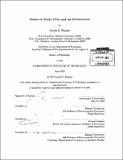| dc.contributor.advisor | Michael Greenstone and Arnaud Costinot. | en_US |
| dc.contributor.author | Shapiro, Joseph S | en_US |
| dc.contributor.other | Massachusetts Institute of Technology. Department of Economics. | en_US |
| dc.date.accessioned | 2013-09-24T19:39:39Z | |
| dc.date.available | 2013-09-24T19:39:39Z | |
| dc.date.copyright | 2013 | en_US |
| dc.date.issued | 2013 | en_US |
| dc.identifier.uri | http://hdl.handle.net/1721.1/81052 | |
| dc.description | Thesis (Ph. D.)--Massachusetts Institute of Technology, Dept. of Economics, 2013. | en_US |
| dc.description | Cataloged from PDF version of thesis. | en_US |
| dc.description | Includes bibliographical references (p. 163-174). | en_US |
| dc.description.abstract | The first chapter of this thesis uses a general equilibrium model of trade and the environment to investigate two questions. First, how do the gains from trade compare against the environmental costs of trade? Trade can generate environmental costs by requiring long-distance transportation of goods and by relocating production to countries that emit a lot of C02 to produce a given good. I find that trade's benefits exceed trade's environmental costs by two orders of magnitude. Second, what are the welfare consequences of proposed EU, US, and global climate change regulations on the carbon emissions from transporting goods? I find that the three proposed policies all increase global welfare. However, they decrease welfare in poor countries, and they provide economic benefits to the implementing region even ignoring environmental consequences. The second chapter (coauthored with Olivier Deschenes and Michael Greenstone) quantifies the magnitude of one defensive investment that people undertake to protect themselves against air pollution. We analyze how the NOx Budget Trading Program, a large cap-and-trade market in the Eastern U.S., affected air pollution emissions, ambient air quality, medication purchases, hospitalizations, and mortality. We find that the market decreased medication expenditures by about $900 million annually. These defensive benefits have similar magnitude to the monetized effect of the market on preventing premature mortality. The third chapter analyzes how the Clean Water Act affected U.S. water pollution levels. By almost any measure, water quality has improved since the 1972 Act. Nonetheless, water quality was improving at similar rates before 1972. The only exception is thermal pollution, which has worsened continually since 1969, presumably due to climate change. I find that the Act's two main activities - wastewater treatment grants and industrial permits - both improved water quality, as indicated by the omnibus measure of dissolved oxygen. At the same time, there is some evidence that the grants increased fecal coliform counts. | en_US |
| dc.description.statementofresponsibility | by Joseph S. Shapiro. | en_US |
| dc.format.extent | 174 p. | en_US |
| dc.language.iso | eng | en_US |
| dc.publisher | Massachusetts Institute of Technology | en_US |
| dc.rights | M.I.T. theses are protected by
copyright. They may be viewed from this source for any purpose, but
reproduction or distribution in any format is prohibited without written
permission. See provided URL for inquiries about permission. | en_US |
| dc.rights.uri | http://dspace.mit.edu/handle/1721.1/7582 | en_US |
| dc.subject | Economics. | en_US |
| dc.title | Essays on trade, CO₂, and the environment | en_US |
| dc.title.alternative | Essays on trade, carbon dioxide, and the environment | en_US |
| dc.type | Thesis | en_US |
| dc.description.degree | Ph.D. | en_US |
| dc.contributor.department | Massachusetts Institute of Technology. Department of Economics | |
| dc.identifier.oclc | 857791628 | en_US |
